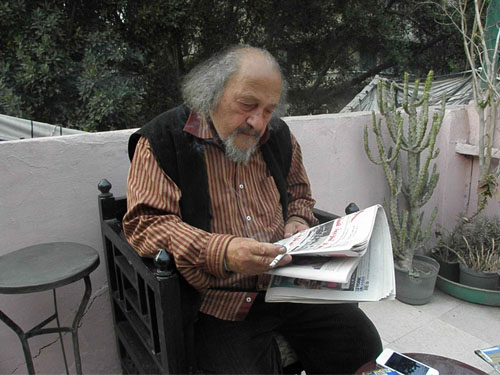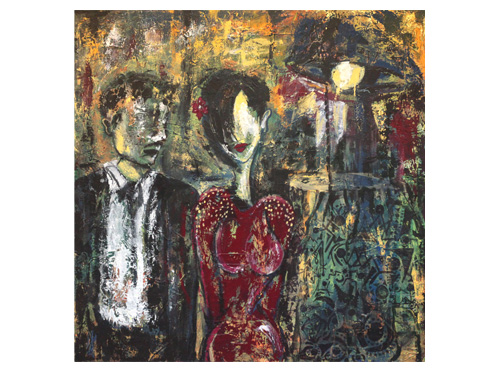Ali Farzat is a hero. He has been criticizing – through his cartoons – the Assad governments since the mid-1960s. But when protests began to intensify against second-generation-despot Bashar al-Assad, something about the scale of government disregard and popular discontent made Farzat take a more direct and antagonistic stance against the ruling government, and specifically Assad.
Cairo Atelier’s current exhibition is a glimpse into the life of Farzat: a collection of his work vilifying the Syrian Regime, as well as the consequences of it. In the adjoining room, a photograph of Farzat brutalized, lying in a hospital bed, eyes bruised and swollen shut, hands bandaged and limply folded across his stomach, stands as a testament to the power of criticism and expression. Neon pink kisses are scattered around his limp figure. Adjacent to the photograph is a compilation of artistic responses to his attack. Cartoonists use the medium to consider both Bashar and Farzat in the images, condemning the former’s brutality and expressing support and solidarity with Farzat.
On one wall of the gallery a large banner is unfurled, asking of passersby to write messages of encouragement to the artist. Throughout this collaborative show, one theme particularly stands out – violence. The banner – a lovely symbol of affection and support marked by the encouraging words of sympathizers – is negated by the dominant message of other participating artists’ illustrations. With the increasing intensity of regime oppression, particularly against Farzat, comes the escalation of violence within the works of these illustrators responding to his attack. The question is whether this violence is symptomatic of the political and artistic culture, condoned as a way of resolving political issues, or whether it is being critiqued in these works, but its presence in the pieces is indisputable.
In August, after the publication of a comic depicting a sweating Assad running toward a getaway car driven by the much-maligned dictator Muammar al-Qadhafi, Farzat was abducted by five armed gunmen and savagely beaten. He was threatened from publishing critical work against the regime, his hands were crushed and broken, and a briefcase full of his drawings was confiscated.
After this deplorable attack against freedom of expression, the artists participating in the exhibition responded more violently to the workings of the Assad regime than Farzat’s subtler and more insightful early work. In the run-up to his assault, Farzat pieces more directly acknowledged Bashar as the source of Syria’s ills, however for the most part his work is metaphorical. While the meanings of the symbols present in his work are clear to any observer, they are discreet. Farzat’s pieces are flush with motifs revolving around the themes of death and decay. Piles of bodies, masses of flesh, wounds, trash and filth mark all of these illustrations clearly as manifestations of societal and moral destitution. Although Bashar does not appear in these images, his presence is pronounced.
Still, Farzat's images are a much subtler critique of the degradation of a society than the far coarser responses of other artists after his attack. Bearing this in mind, the exhibition at the Cairo Atelier seems especially pertinent to those considering the future of freedom of expression in this country and the fate of power and tyranny. While protests in Egypt and Syria started at a similar time earlier this year, the responses of their governments against their citizenry have been drastically different. Indeed, the former country faces an uncertain transition period after its dictator was deposed, and the latter continues to deal out harsher and more draconian punishments to those who speak out against its tyrant.
In all likelihood, these pieces simply mirror the same violence the state was exacting on its citizens and Farzat within those moments, but should violence equal violence? Walking through the exhibition gives the viewer a visceral reaction to imagery that is, at moments, graphic and sickening. One illustration depicts a fountain pen ridden like a broomstick impaling Assad through his anus and out his mouth. The fountain pen bears the name of Farzat along its skewered point, yet is illustrated by Egyptian cartoonist Mohamed al-Sabbagh. The naming of Farzat on the pen suggests his victory in condemning Bashar, but also brings up issues of artistic ownership. It is difficult to say whether Farzat would appreciate his name being used on a weapon to harpoon the dictator in such a thuggish manner, and the viewer is denied the opportunity to consider this possibility because the piece is so shocking.
Another piece – the only mixed-media piece in the show – is a series of talisman-like voodoo doll puppets roughly sewn onto a burlap-covered board. The words brandished across the top read, “The people want to bring down Bashar,” another nod to similar slogans present throughout Egypt’s political upheaval. The rough, loosely woven burlap is stitched in a haphazard and aggressive fashion, the position of the dolls suggesting a lack of mobility and suffocation. The idea of being stitched savagely to burlap seems to reflect these feelings of subjugation, contrasted with the appearance of these cute and childlike doll figures.
What seems so tragic about the exhibition is noticing the way dictatorship, cruelty and its repressive prerequisites have affected the spirit of the artists showing solidarity with Farzat. It’s almost as if we are witnessing the provocations of government through the works of this collection of artists, and the results of these abuses are full of the same sentiments of anger and fear. In effect, we witness such a level of societal trauma that violence in these images is a resolution. And naturally, their images prove to be a consequence of the political moments that produced them. While Farzat’s work speaks in a code that rejects directly proclaiming the guilt or liability of particular individuals within the regime, his assault apparently allows us to excuse violence to defend him. And the contrast between his earlier images of horse faces underneath horse masks, generals and mirrors, become the violent sodomy of Assad on a witch’s broom-pen.


